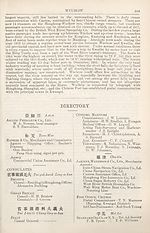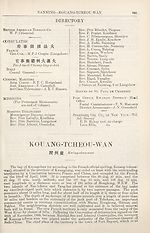1918
(996) [Page 920] - Nanning
Download files
Complete book:
Individual page:
Thumbnail gallery: Grid view | List view
![(996) [Page 920] - Nanning](https://deriv.nls.uk/dcn17/1949/0628/194906280.17.jpg)
JN ANNIN G
nr* Nan-wing
The port of Nanning, declared open to foreign trade on the 1st January, 1907, is
situated on the left bank of the Tso-Kiang, one of the branches of the West River, 368
miles above Wuchow and about 195 miles below Lungchow, the frontier port on the
Tonkinese border. It lies in the centre of a wide fertile plain in a sharp oend of the
river, which there describes nearly two-thirds of the arc of a circle. It is a hsien city
and is the seat of the Chiang Chun and Hsiin An Shih and Military and Civil
Governors of Kwangsi Province. Below the walled city and adjacent to the lower
suburbs is the site which has been set apart for a Settlement; it occupies the only
spot near the city which is above high-water mark. The regulations do not allow
the purchase of land on the Settlement site, but merely its lease for 30 years, which
fieriod may be extended on expiry for another 30 years. Foreigners desiring to lease
and must apply through their Consul.
The net value of the trade of the port advanced from Hk. Tls. 1,544,000 in 1907
to Hk. Tls. 5,385,478 in 1910, but dropped to Hk. Tls. 4,700,517 in 1911. The
value of trade during 1916, when disturbed domestic politics restricted trade not only in
the Nanning district but throughout the whole province, was Hk. Tls. 7,151,523 as compar¬
ed with Hk. Tls. 7,798,661 in 1915 which is the record year. The dislocation of trade in
antimony was a disturbing event which impeded the extension of a particular branch
of business on which great expectations had been based. The turn came unexpectedly
in April, when pre-war conditions suddenly reasserted themselves, and well before the
end of the year dealers had been forced to realise that the business was a hopeless one
in which much money had been lost. Shipping returns show an increased tonnage and
shipping interests suffered less than is usually the case during the low water season.
The bulk of the carrying trade is now done by motor boats, of which there is a fleet
of 24 plying regularly throughout the year between Wuchow and Nanning, but rates
of freight are low, and increasing competition caused by the building of new boats and
the resultant cutting of prices has tended to operate to the disadvantage of the various
shipping companies. The round trip can be made by motor boat from Wuchow
in five to six days as against the journey by junk which takes about twenty days on
the upward trip only. The only Europeans residing there at present are missionaries
and the Customs staff, and one foreign firm.
Nanning is, next to Wuchow, the most important port on the West River. The
site selected for the foreign settlement covers a very extensive area and is situated
where the old city formerly stood, about a mile distant from the present walled city.
Whether the area set apart for international residence and trade is ever likely to be
fully occupied it is perhaps early yet to say.
It is only to be expected that enhanced prosperity together with an influx of
officials and well-to-do merchants consequent on the transfer of the capital from
Kueilin, and a general spread of civilisation, should engender a desire to adopt a state
of life similar to that enjoyed in other parts of the republic in closer touch with
western ideas. The establishment of a number of new shops and the enlargement of
others may be held to indicate that the city population is more eager than ever to
supply itself with various imported articles which it has learned to recognise as
rendering existence more comfortable.
nr* Nan-wing
The port of Nanning, declared open to foreign trade on the 1st January, 1907, is
situated on the left bank of the Tso-Kiang, one of the branches of the West River, 368
miles above Wuchow and about 195 miles below Lungchow, the frontier port on the
Tonkinese border. It lies in the centre of a wide fertile plain in a sharp oend of the
river, which there describes nearly two-thirds of the arc of a circle. It is a hsien city
and is the seat of the Chiang Chun and Hsiin An Shih and Military and Civil
Governors of Kwangsi Province. Below the walled city and adjacent to the lower
suburbs is the site which has been set apart for a Settlement; it occupies the only
spot near the city which is above high-water mark. The regulations do not allow
the purchase of land on the Settlement site, but merely its lease for 30 years, which
fieriod may be extended on expiry for another 30 years. Foreigners desiring to lease
and must apply through their Consul.
The net value of the trade of the port advanced from Hk. Tls. 1,544,000 in 1907
to Hk. Tls. 5,385,478 in 1910, but dropped to Hk. Tls. 4,700,517 in 1911. The
value of trade during 1916, when disturbed domestic politics restricted trade not only in
the Nanning district but throughout the whole province, was Hk. Tls. 7,151,523 as compar¬
ed with Hk. Tls. 7,798,661 in 1915 which is the record year. The dislocation of trade in
antimony was a disturbing event which impeded the extension of a particular branch
of business on which great expectations had been based. The turn came unexpectedly
in April, when pre-war conditions suddenly reasserted themselves, and well before the
end of the year dealers had been forced to realise that the business was a hopeless one
in which much money had been lost. Shipping returns show an increased tonnage and
shipping interests suffered less than is usually the case during the low water season.
The bulk of the carrying trade is now done by motor boats, of which there is a fleet
of 24 plying regularly throughout the year between Wuchow and Nanning, but rates
of freight are low, and increasing competition caused by the building of new boats and
the resultant cutting of prices has tended to operate to the disadvantage of the various
shipping companies. The round trip can be made by motor boat from Wuchow
in five to six days as against the journey by junk which takes about twenty days on
the upward trip only. The only Europeans residing there at present are missionaries
and the Customs staff, and one foreign firm.
Nanning is, next to Wuchow, the most important port on the West River. The
site selected for the foreign settlement covers a very extensive area and is situated
where the old city formerly stood, about a mile distant from the present walled city.
Whether the area set apart for international residence and trade is ever likely to be
fully occupied it is perhaps early yet to say.
It is only to be expected that enhanced prosperity together with an influx of
officials and well-to-do merchants consequent on the transfer of the capital from
Kueilin, and a general spread of civilisation, should engender a desire to adopt a state
of life similar to that enjoyed in other parts of the republic in closer touch with
western ideas. The establishment of a number of new shops and the enlargement of
others may be held to indicate that the city population is more eager than ever to
supply itself with various imported articles which it has learned to recognise as
rendering existence more comfortable.
Set display mode to:
![]() Universal Viewer |
Universal Viewer | ![]() Mirador |
Large image | Transcription
Mirador |
Large image | Transcription
Images and transcriptions on this page, including medium image downloads, may be used under the Creative Commons Attribution 4.0 International Licence unless otherwise stated. ![]()
| Asian directories and chronicles > 1918 > (996) [Page 920] - Nanning |
|---|
| Permanent URL | https://digital.nls.uk/194906278 |
|---|
| Attribution and copyright: |
|
|---|---|
| Description | Volumes from the Asian 'Directory and Chronicle' series covering 1917-1941, but missing 1919 and 1923. Compiled annually from a multiplicity of local sources and research. They provide listings of each country's active corporations, foreign residents and government agencies of all nationalities for that year, together with their addresses. Content includes: various treaties; coverage of conflicts; currencies and taxes; consular fees; weights and measures; public holidays; festivals and traditions. A source of information for both Western states and communities of foreigners living in Asia. Published by Hongkong Daily Press. |
|---|---|
| Shelfmark | H3.86.1303 |
| Additional NLS resources: |

